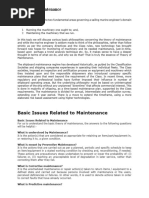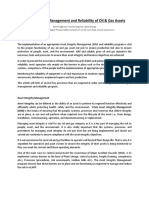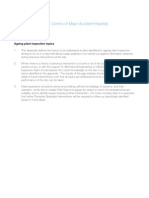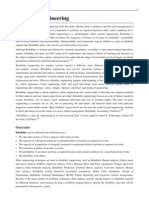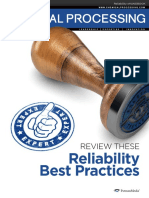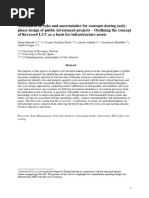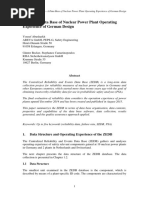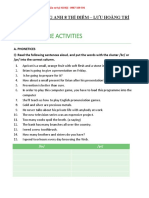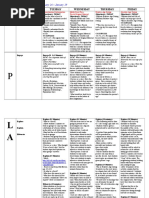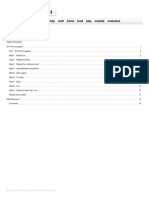Track 1 - Cesar Malpica - Paper
Track 1 - Cesar Malpica - Paper
Uploaded by
fredyCopyright:
Available Formats
Track 1 - Cesar Malpica - Paper
Track 1 - Cesar Malpica - Paper
Uploaded by
fredyOriginal Title
Copyright
Available Formats
Share this document
Did you find this document useful?
Is this content inappropriate?
Copyright:
Available Formats
Track 1 - Cesar Malpica - Paper
Track 1 - Cesar Malpica - Paper
Uploaded by
fredyCopyright:
Available Formats
SAFETY AND RELIABILITY; HOW DO THE SAFETY AND RCM ANALYSES
CAN WORK TOGETHER?
César Malpica, CMRP Oswaldo Moreno, TUV Ernesto Primera, CMRP
Staff Reliability Engineer SIS Engineer Reliability Engineer
Chevron Chevron Chevron
Energy Technology Company Energy Technology Company Latino America Business Unit
Introduction
Reliability Centered Maintenance (RCM) has been used in several industries (i.e. aeronautical,
nuclear, oil and gas) for very long time with documented success to provide facilities with the
most cost benefit asset strategies. Although there are many other times that RCM hasn’t been
able to fulfill customer’s expectations (customer is also referred as “user”) for effectiveness and
cost reduction, it still meets the definition of a best practice — a process that, if repeated, will
consistently provide the desired outcome. The RCM reached a high level of maturity and already
went over a learning curve that made its implementation either a well-known common practice
or a practice to avoid due to some very unsuccessful projects. However, RCM has been adopted
by the majority of users (i.e. airlines, nuclear power plants, petrochemical complex and O&G
facilities), and it is fair to say it is a best practice, even it is no longer a differentiator.
RCM implementation requires that many parties interact and address a broad range of asset types
and organizational processes. RCM is great to manage the collective knowledge of asset’s team
by expert elicitation and performance review. As successful you are identifying and mitigating
RCM failure modes, as successful you will be on managing a safe and reliable and profitable
asset.
In this paper, the author shares a modern approach to perform RCM in an integrated manner with
other industry standard and best practices related to safety; process hazard analysis. The silos-
based organization has the opportunity to promote a safer and more efficient facility if reliability
and safety related activities are planned and performed in such a manner that both are as much as
possible integrated and supported by each other.
Failure on implementing the reliability and safety programs (e.g. asset integrity ) can conduct to
very critical accidents like the ones registered in the Gulf of Mexico and other locations in the
past years; these accidents affected the assets, injured people and the nature was heavily
impacted. It happened due to a lack of the implementation of reliability and asset integrity
programs. It “must” be avoided. It “Can” be avoided. An “incident-free” operation is achievable.
The Process Hazard Analyses (PHA) provides the engineering team with the identification of
those critical hazard scenarios that “do have or don’t have” enough safeguards in place to either
mitigate or avoid the occurrence of such scenarios.
The Safety Integrity Level (SIL) analysis departs from the process hazards identification and the
validation of the safeguards to recommend what should be done from design, testing and
C. Malpica & O. Moreno & E. Primera Page 1 of 10
Chevron – October 2014
maintenance to accredit such safeguards as one of the required “Independent Protection Layer”
for the analyzed hazard scenario.
While the RCM has become in one of the most recognized “Reliability Best Practices” endorsed
by SAE J1011 and ASTM, the PHA/SIL analysis has been endorsed by the IEC61508/IEC61511,
API14C and other organizations to be a “Must-to-Do” in process plants. Both, the RCM and the
PHA/SIL are founded on the concept of becoming part of the life cycle of the assets (“living
program”).
Definitions
The following definitions will help as we begin our understanding of RCM:
Reliability-Centered Maintenance (RCM): A systematic process used to determine what must be
done to ensure that any physical asset continues to fulfill its intended functions in its present
operating context.
Failure Mode and Effects Analysis (FMEA): A design evaluation procedure used to identify
failure modes and to determine the effect of each on system performance; a procedure in which
each potential failure mode in every sub-item of an item is analyzed to determine its effect in
other sub-items and on the required function of the item.
Predictive Maintenance (PdM): The use of modern measurement and signal processing
techniques to accurately diagnose the condition of equipment (level of deterioration) during
operation. The PdM is accomplished by the periodic measurement and trending of process or
machine parameters with the aim of predicting failures before they occur. The objective is to
predict or anticipate when maintenance is required through condition monitoring of equipment.
Examples are vibration monitoring, lubricant analysis and leak detection.
Preventive Maintenance (PM): Actions performed in an attempt to retain an item in specified
condition by providing systematic inspection and detection. The goal is to control potential
failures in their early stage and includes basic housekeeping, periodic/systematic inspection,
detection and daily routine maintenance (e.g., adjustments, replacements) to prevent
deterioration.
Failure-Finding Task (FF): A failure-finding task is defined as a scheduled task used to
determine whether or not an item is able to fulfill its intended function when demanded. It is
solely intended to reveal if a specific hidden failure has occurred. Failure-finding tasks usually
apply to protective devices that fail without notice.
Corrective Maintenance (CM): Unplanned maintenance tasks performed to restore the functional
capabilities of failed or malfunctioning equipment.
One-Time Task: It may be desirable to reduce the risk of failure by recommending redesign of
the asset or to propose modification of existing equipment, operating procedures, or spare supply
strategy. These recommendations are called “one-time tasks.”
Run-to-Failure: No scheduled maintenance. No effort to anticipate or prevent failure modes that
do not have intolerable impact. The failure mode is simply allowed to occur and then repaired.
C. Malpica & O. Moreno & E. Primera Page 2 of 10
Chevron – October 2014
Criticality Analysis: An assessment of the impacts on safety, environment and production that
can occur if an asset fails. It is intended to determine the risk associated with such failure and
prioritize under a risk-cost-benefit concept the actions needed to either mitigate the impact or
reduce the probability of its occurrence to tolerable levels.
Availability: The ability of an item to be in a state to perform a required function under given
conditions at a given instant of time or over a given time interval, assuming that the required
external resources are provided.
Maintainability: Ability of an item under given conditions of use, to be retained in, or restored to,
a state in which it can perform a required function, when maintenance is performed under given
conditions and using stated procedures and resources.
Spare Parts Optimization: Risk-cost-benefit study performed to determine which parts and how
many of them should be stocked to assure the maintainability and optimum availability of
process plants.
Task Selection: Process followed during RCM for deciding which of the proactive tasks (if any)
is technically feasible in any context and, if so, for deciding how often they should be done and
who should do them.
Task Analysis: Task analysis is the analysis of how a task is accomplished, including a detailed
description of both manual and mental activities, task and element durations, task frequency, task
allocation, task complexity, environmental conditions, necessary clothing and equipment, and
any other unique factors involved in or required for one or more people to perform a given task.
Reliability Centered Maintenance
Overview
The primary objective of any RCM process is to preserve system functions. A system function is
typically defined in terms of system output, throughput, safety and environment or even cost.
Preserving system function may then be reasonably defined as doing what is required to keep the
overall system operating to the level where it meets its performance targets (i.e., prescribed
output, throughput, asset integrity).
Maintenance strategies such as preventive maintenance (PM) and predictive maintenance (PdM)
among others are developed for each asset within the facility only after evaluating the role of it
in preserving the system function. Once the maintenance strategies are developed, specific
maintenance tasks and monitoring practices are developed based upon documented and traceable
decisions of what should be done, why and by whom.
It is also possible that, based on a risk-cost-benefit analysis it is decided not to do any proactive
task to prevent the failure (run-to-failure strategy). This is an acceptable strategy if the cost of
doing the proactive maintenance to avoid the failure is higher than the impact if the failure
occurs.
The RCM methodology can be applied in any upstream or downstream facility where operations,
maintenance and reliability are interested in starting an effort to assure the optimum availability
of processes and reliability of assets.
C. Malpica & O. Moreno & E. Primera Page 3 of 10
Chevron – October 2014
References
The following documents provide information and support the implementation of RCM
programs in the industry:
CEI IEC 60300-3-11 International Standard, Dependability Management –
Part 3–11: Application Guide – Reliability-Centered Maintenance, First Edition, 1999-03
SAE JA1011, Evaluation Criteria for Reliability-Centered Maintenance (RCM) Processes
SAE JA1012, A Guide to the Reliability-Centered Maintenance (RCM) Standard
Moubray, John; Reliability-Centered Maintenance RCMII, 1997
Procedure
In order for the process to work properly, the answers to seven questions are required as input to
the process:
1. What are the functions and associated performance standards of the asset in its
present operating context?
2. In what ways does it fail to fulfill its functions?
3. What causes each functional failure?
4. What happens when each failure occurs? What is the effect of the failure?
5. In what way does each failure matter? Is it evident for the operator under normal
operating conditions?
6. What can be done to predict or prevent each failure?
7. What should be done if a suitable proactive task cannot be found?
Figure 1: RCM Procedure
C. Malpica & O. Moreno & E. Primera Page 4 of 10
Chevron – October 2014
Process Hazard Analysis (HAZOP)
Overview
Process Hazard Analysis (PHA) is a generic term used for describing qualitative risk assessments.
PHA may use various methodologies, such as Hazard and Operability (HAZOP) or What/If
Checklist review. PHAs are key components for implementation of Process Safety Management
process in the Oil & Gas industry.
Hazard and operability study (HAZOP) is a structured and systematic technique for examining a
defined system, with the objective of:
Identifying potential hazards in the system
Identifying potential operability problems with the system and in particular identifying
causes of operational disturbances and production deviations likely to lead to non-
conforming products.
An important benefit of HAZOP studies is that the resulting knowledge, obtained by identifying
potential hazards and operability problems in a systematic manner, is of great assistance in
determining appropriate remedial measures.
A characteristic feature of a HAZOP study is the “examination session” during which a multi-
disciplinary team under the guidance of a study leader systematically examines all relevant parts
of a design or system.
References
The following documents provide information and support the implementation of PHA / HAZOP
programs in the industry:
CEI IEC 61882 Hazard and Operability Studies – Application guide, First Edition, 2001-
05
IEC/ISO 31010 Risk Assessment techniques, First edition, 2009-11
IEC61160 Design Review, Second edition, 2005-9
Procedure
The steps to conduct a HAZOP study can be listed as follows:
Choose study node
Understand the design intend
Brainstorm causes of deviations from normal operation
Develop each cause to its global consequence(s)
For those scenarios having consequences of interest, identify existing safeguards
For those scenarios having consequences of interest, qualitatively assess the severity of
the predicted consequences and the likelihood that those consequences will develop, and
determine the Risk Priority Rating of the scenario
If warranted, make recommendation(s) to reduce risk
Repeat process for each consequence identified and / or study section
Table 1shows a typical form to gather information and document the results of HAZOP.
C. Malpica & O. Moreno & E. Primera Page 5 of 10
Chevron – October 2014
Relationship between HAZOP and RCM
The HAZOP can be either complemented or in conjunction with FMEA what is also a
constituent part of RCM. The process followed to identify deviations / causes and assess
consequences may be understood as the one required by RCM for failure mode / cause and effect
/ consequence respectively. Figure #1 shows where both HAZOP and RCM can be interfacing to
meet their own objectives for design review and further asset strategies development.
Figure 2: Hazard and Operability Study Procedure
Safety Integrity Level (SIL)
Overview
Safety Integrity Level (SIL) is a formal process that utilizes the results of a PHA to determine the
safety system instrumentation required to prevent and mitigate hazardous events in downstream,
chemical, and upstream onshore processes. The SIL study relies on the hazardous scenario
causes, consequences, and safeguards developed during the PHA (HAZOP) as a starting point
for determining whether adequate risk reduction has been provided for each cause-consequence
scenario using Independent Protection Layers (IPLs) and recommending additional measures to
further mitigate the risk as necessary.
The SIL study is a structured process to validate the IPL safeguards and determine the
performance required of Safety Instrumented Functions (SIFs).
C. Malpica & O. Moreno & E. Primera Page 6 of 10
Chevron – October 2014
References
The following important influential documents / standards provide information and support the
implementation of SIL study in the Oil & Gas industry:
IEC 61508: Functional Safety – Safety Related Systems- 1998 / 2000
IEC 61511: Functional Safety: Safety Instrumented Systems for the Process Industry
Sector: Parts 1, 2 & 3 –June 2003
ANSI/ISA 84.00.01-2004 (IEC 61511 MOD) – Functional Safety: Safety Instrumented
Systems for the Process Industry Sector – Parts 1, 2 & 3 with Grandfather Clause
Procedure
The steps to conduct a SIL study may differ from every user’s procedure however; basic steps
based on LOPA methodology (Layers Of Protection Assessment) are listed below:
Complete all HAZOP steps (see HAZOP section above)
The cause, consequence, safeguards, and severity ranking for each cause-consequence
scenario are copied over from the PHA worksheets (HAZOP).
Determine Total number of IPL (Independent Protection layer) credits required
Identify all IPLs
Determine IPL credit gap
Create SIL Recommendations
Repeat until all hazards are evaluated
Independent Protection Layer
Safeguards are credited as IPL if meet the following criteria (per guidance from the Center for
Chemical Process Safety):
Specificity (designed specifically to prevent or mitigate the consequences of one event)
Independence (independent of other protection layers for the hazard)
Dependability (will do what it is designed to do)
Auditability (designed to accommodate required testing and maintenance for regular
validation)
To determine whether or not a safeguard qualifies as an IPL, consider the “3 D’s” and the “Big I”
as follows:
1. An IPL must have the following “3 D’s”:
a. Detect—Sense a condition or problem,
b. Decide—Whether an action or intervention is necessary or not,
c. Deflect—If action is required; the action must be capable of preventing the
consequence in a timely manner.
2. And, an IPL must have the “Big I”:
a. Independent of initiating cause
b. Independent of other IPLs
C. Malpica & O. Moreno & E. Primera Page 7 of 10
Chevron – October 2014
SIL Verification
Safety Integrity Level (SIL) verification is required to ensure that target SIL for each SIF is
achieved by the proposed conceptual design and according to other requirements established in
the SIS functional requirements.
The procedure, scope, frequency and documentation of functional testing are critical aspects of
SIL verification. The target SIL and achieved SIL will be used to determine or adjust the scope
and frequency of functional testing. The RCM team should use the SIL functional testing as an
input for the tasks selection exercise.
Special Case: API14C covered facilities
API14C is a recommended practice for analysis, design, installation, and testing of basic surface
safety systems for Offshore production platforms.
The main objectives API14C are:
To prevent release of hydrocarbons from the process and minimize adverse effects
Provides Requirements for Operating Modes of the Safety System
Standardized Design and Testing
API14C requires the planning and execution of prescriptive tasks for functional testing of safety
devices. The Integrity of offshore facilities is achieved by prescriptive high frequency testing that
has no recognition of magnitude of risk.
Relationship between SIL and RCM
The SIL can either complement or be done in conjunction with RCM as both provide asset
strategies for operations and maintenance. The process followed to identify failure finding and
functional testing may be understood as required by RCM and SIL studies. Figure #3 shows
where both SIL and RCM can be interfacing to meet their own objectives for asset strategies
development.
RCM can’t overwrite API14C prescriptive tasks as they are mandatory in USA and many other
countries or transnational companies have adopted to set minimum requirements on scope and
frequency of functional testing. The RCM facilitator should work with the team members to
know if API14C is followed for the installation subject of RCM.
The Figure 3 shows how SIL study and RCM can be related to each other.
C. Malpica & O. Moreno & E. Primera Page 8 of 10
Chevron – October 2014
Figure 3: Safety Integrity Level Analysis Procedure
Lessons learned
The integration of safety related studies and reliability have allowed the project team to
document the following lessons learned that can be now shared with other project teams,
business units and peers in the O&G industry.
Plan is needed for both reliability and safety related tasks early in each project execution
phase (if not complete late in previous phase) to ensure that funds and resources are
allocated to fully support the successful implementation
Reliability and Safety teams should ensure that scope and schedule and expectations are
not only shared but adopted by each team in order to ensure a seamless integration and
delivery of safer and more reliable assets
If it is well coordinated, the execution of reliability and safety related workshop will
provide inputs to each other and optimize the resource allocation as well as ensure
consistency across the studies and accuracy of results (risk assessment and asset
strategies)
Third parties and contractors need to be educated on how to deliver an integrated
approach for reliability and technical safety, Currently, the silos-based organization does
not only belong to users but it is also replicated in most of the reliability and service
providers. It is common to find contractors that only provides specialized services on the
application of a single methodology but don’t go beyond that to offer a more holistic and
integrated reliability program implementation
The leverage from existing industry standard and best practices allows the
implementation of programs that cover the entire value chain of reliability engineering
C. Malpica & O. Moreno & E. Primera Page 9 of 10
Chevron – October 2014
(e.g. ISO20815, API17N, IEC60300). The current experience in the O&G industry
provide frame and add purpose to the execution of reliability studies as they are now
more oriented to safety and business continuity.
Summary
There are some clear and compelling interactions between RCM and PHA studies regarding the
identification of critical failure modes, causes and definition of tasks to either mitigate the risk or
reduce to a tolerable level the probability of its occurrence. Failing to adopt an integrated
approach to perform safety related studies (PHA) and reliability analyses, will avoid the team to
achieve optimum resource allocation, consistency of results across the studies (i.e. risk
assessment, failure mode) and most effective tasks to mitigate associated risks.
The Figure 4 shows the lessons learned derived from the application of safety-focused RCM.
Benefits have been well recognized for closing the gap between reliability and Safety teams and
processes.
Figure 4: Lessons learned from the application of HES focused RCM
Keywords:
1. Reliability
2. Safety
3. Process Hazard Analysis
4. Maintenance
5. SIL Safety Integrity Level
6. Reliability Centered Maintenance
C. Malpica & O. Moreno & E. Primera Page 10 of 10
Chevron – October 2014
You might also like
- Maintenance EngineeringDocument67 pagesMaintenance EngineeringV.Muthu KumarNo ratings yet
- Tools of TerotechnologyDocument7 pagesTools of TerotechnologyCharles Ondieki100% (3)
- Maintenance Strategy Based On A Multicriterion Classification of EquipmentsDocument8 pagesMaintenance Strategy Based On A Multicriterion Classification of EquipmentsSuraj KumarNo ratings yet
- Asset Management - MindMAPDocument1 pageAsset Management - MindMAPPessoa Dali100% (3)
- Total Productive Maintenance For Organisational EffectivenessFrom EverandTotal Productive Maintenance For Organisational EffectivenessRating: 4 out of 5 stars4/5 (5)
- Mep e Learning.1Document506 pagesMep e Learning.1Chethan PatwalNo ratings yet
- Reliability Centred MaintenanceDocument8 pagesReliability Centred MaintenancemiriamanastasioNo ratings yet
- Application of Reliability Centred Maintenance To Dynamic PlantDocument13 pagesApplication of Reliability Centred Maintenance To Dynamic Plantgvc1No ratings yet
- Reliability Centered Maintenance RCM Implementation and BenefitsDocument4 pagesReliability Centered Maintenance RCM Implementation and BenefitsNguyễn Duy KhangNo ratings yet
- fLmOMkiHTESrm1LCcfyC - Asset Integrity Management and Reliability of Oil and Gas AssetsDocument4 pagesfLmOMkiHTESrm1LCcfyC - Asset Integrity Management and Reliability of Oil and Gas AssetsMuhammad AdnanNo ratings yet
- IT 3976 Reliability Centered Maintenance (Wikipedia)Document6 pagesIT 3976 Reliability Centered Maintenance (Wikipedia)Gera MtzNo ratings yet
- What Is Reliability - Centered MaintenanceDocument6 pagesWhat Is Reliability - Centered Maintenancearchie zambranoNo ratings yet
- Failure Defense PlanningDocument5 pagesFailure Defense PlanningManel Montesinos100% (1)
- 1-s2.0-S0957582015002190-mainDocument13 pages1-s2.0-S0957582015002190-mainJanlean NTUNo ratings yet
- 2018 - AIM - Equipos Críticos PDFDocument9 pages2018 - AIM - Equipos Críticos PDFNachoNo ratings yet
- Reliability Centered Maintenance White PaperDocument7 pagesReliability Centered Maintenance White PaperRoman AhmadNo ratings yet
- Rbi RBMDocument12 pagesRbi RBMn73686861No ratings yet
- TERNIDADocument10 pagesTERNIDADranreb Jazzver BautistaNo ratings yet
- Reliability Centered Maintenance - Wikipedia PDFDocument37 pagesReliability Centered Maintenance - Wikipedia PDFEndhy Wisnu NovindraNo ratings yet
- CBM RAM Dec 2019(1)Document12 pagesCBM RAM Dec 2019(1)emmanuel wilsonNo ratings yet
- Reliability Centered MaintenanceDocument10 pagesReliability Centered MaintenanceengrhazrataliuetmNo ratings yet
- Reliability Centered Maintenance in Industrial Planning - A Case StudyDocument6 pagesReliability Centered Maintenance in Industrial Planning - A Case StudycuongNo ratings yet
- Chapter 6: Mitigating Hazards Via A Process Safety Management SystemDocument20 pagesChapter 6: Mitigating Hazards Via A Process Safety Management SystemGiancarloErrigoNo ratings yet
- Reliability Centered MaintenanceDocument15 pagesReliability Centered MaintenanceEdmund YoongNo ratings yet
- Critical Equipment Identification and MaintenanceDocument4 pagesCritical Equipment Identification and MaintenanceAramis Alfonso LlanesNo ratings yet
- ReliabilityDocument4 pagesReliabilitymurilobpessanhaNo ratings yet
- ACTIVIDAD1 - Practical Aspects of The Application of RCMDocument10 pagesACTIVIDAD1 - Practical Aspects of The Application of RCMeduardoperez.uniNo ratings yet
- A Practical Approach To Managing Safety Critical Equipment and Systems in Process PlantsDocument10 pagesA Practical Approach To Managing Safety Critical Equipment and Systems in Process Plantsfredo405No ratings yet
- Reliability Centered Maintenance - Wikipedia, The Free EncyclopediaDocument7 pagesReliability Centered Maintenance - Wikipedia, The Free EncyclopediarenjithaeroNo ratings yet
- Examining The Processes of RCM and TPMDocument15 pagesExamining The Processes of RCM and TPMadityanarang147No ratings yet
- A Risk-Based Shutdown Inspection and Maintenance Interval Estimation Considering Human ErrorDocument13 pagesA Risk-Based Shutdown Inspection and Maintenance Interval Estimation Considering Human Erroramira_zainal92No ratings yet
- TB014-Reliability Centered Maintenance White PaperDocument7 pagesTB014-Reliability Centered Maintenance White PaperVinitJory100% (1)
- Integrity Management of Safety Critical Rotating Equipment and SystemsDocument17 pagesIntegrity Management of Safety Critical Rotating Equipment and Systemsuserscribd2011No ratings yet
- RCM Alan PrideDocument16 pagesRCM Alan PrideambuenaflorNo ratings yet
- RCMDocument43 pagesRCMmemorysuwediNo ratings yet
- Reliability Centered Maintenance in Industrial Planning - A Case StudyDocument6 pagesReliability Centered Maintenance in Industrial Planning - A Case Studybirhan getayeNo ratings yet
- RCM in Nuclear Power PlantsDocument13 pagesRCM in Nuclear Power PlantsAmar SaadiNo ratings yet
- RCM XXXDocument11 pagesRCM XXXOmar KhaledNo ratings yet
- 2.0life Extension of Offshore Assets - Balancing Safety and Project EconomicsDocument9 pages2.0life Extension of Offshore Assets - Balancing Safety and Project Economics翀 曹No ratings yet
- Reliability and Condiditon Based MaintenanceDocument22 pagesReliability and Condiditon Based Maintenanceehrafi2067No ratings yet
- Safety Critical Elements - Performanace Standards EngineeringDocument4 pagesSafety Critical Elements - Performanace Standards EngineeringKarthikeyan Varathan100% (3)
- Reliability Centred Maintenance (RCM)Document9 pagesReliability Centred Maintenance (RCM)GraceNo ratings yet
- Definition and Process DescriptionDocument4 pagesDefinition and Process DescriptionManel Montesinos100% (1)
- Maintenance EngineeringDocument34 pagesMaintenance EngineeringpsenthilpkumarNo ratings yet
- Ageing Plant App5Document16 pagesAgeing Plant App5Mas Arman TewoNo ratings yet
- Technical Report Concerning RCM. by Elisony Edward Mweladzi. Dar Es Salaam Tanzania +255 754321825Document14 pagesTechnical Report Concerning RCM. by Elisony Edward Mweladzi. Dar Es Salaam Tanzania +255 754321825Elisony EdwardNo ratings yet
- API691 Risk Based Machinery ManagementDocument34 pagesAPI691 Risk Based Machinery ManagementJulio Cesar WagnerNo ratings yet
- Preventive Maintenance Part IDocument20 pagesPreventive Maintenance Part Ismodi20No ratings yet
- Is 4002 Maintainability EngineeringDocument118 pagesIs 4002 Maintainability Engineeringraj KumarNo ratings yet
- Reliability EngineeringDocument18 pagesReliability EngineeringSanti KunduNo ratings yet
- Best Reasons To Use RCM - Optimizing Lean Manufacturing: Carlo Odoardi, MengDocument6 pagesBest Reasons To Use RCM - Optimizing Lean Manufacturing: Carlo Odoardi, MengElvis DiazNo ratings yet
- Tero TechnologyDocument8 pagesTero TechnologyCharles Ondieki100% (1)
- RCM and Digital TechnologyDocument6 pagesRCM and Digital TechnologyAnis SuryadiNo ratings yet
- Reliability EngineeringDocument31 pagesReliability Engineeringshreeram79No ratings yet
- Reliability Best Practices: Review TheseDocument18 pagesReliability Best Practices: Review TheseSV SANKARAMOORTHYNo ratings yet
- Condition-Based Monitoring ShiftDocument3 pagesCondition-Based Monitoring ShiftCyrix.One100% (1)
- Reliability Centered Maintenance: DescriptionDocument2 pagesReliability Centered Maintenance: DescriptionOmar KhaledNo ratings yet
- Machine Reliability and Condition Monitoring: A Comprehensive Guide to Predictive Maintenance PlanningFrom EverandMachine Reliability and Condition Monitoring: A Comprehensive Guide to Predictive Maintenance PlanningRating: 4.5 out of 5 stars4.5/5 (2)
- Sesion II - 3-ESREDA 2016 - ES - VGP - AG - AC - JS - V12 - FINAL - 25.04.2016 - Revised Based On ReviewedDocument15 pagesSesion II - 3-ESREDA 2016 - ES - VGP - AG - AC - JS - V12 - FINAL - 25.04.2016 - Revised Based On ReviewedfredyNo ratings yet
- Sesion IV - 2-ZEDB Paper For ESREDA-FinalDocument15 pagesSesion IV - 2-ZEDB Paper For ESREDA-FinalfredyNo ratings yet
- BoéroDocument11 pagesBoérofredyNo ratings yet
- BognarDocument12 pagesBognarfredyNo ratings yet
- Zafar HameedDocument15 pagesZafar HameedfredyNo ratings yet
- BackstromDocument12 pagesBackstromfredyNo ratings yet
- Track 1 - Mark Keneipp - PaperDocument7 pagesTrack 1 - Mark Keneipp - PaperfredyNo ratings yet
- An Introduction To Probability Models in Reliability and MaintainabilityDocument9 pagesAn Introduction To Probability Models in Reliability and MaintainabilityfredyNo ratings yet
- 13a KatonaDocument12 pages13a KatonafredyNo ratings yet
- 02 Jeff Dudley Conference KeynoteDocument38 pages02 Jeff Dudley Conference KeynotefredyNo ratings yet
- Sumitomo HSM July07 BrochureDocument4 pagesSumitomo HSM July07 BrochurefredyNo ratings yet
- Answer To Defendant Alemond Motion To Stay Proceedings Pursuant To Service Members Civil Relief ActDocument16 pagesAnswer To Defendant Alemond Motion To Stay Proceedings Pursuant To Service Members Civil Relief ActMarc MkKoyNo ratings yet
- List of Moments of Inertia: From Wikipedia, The Free Encyclopedia 2Document3 pagesList of Moments of Inertia: From Wikipedia, The Free Encyclopedia 2Agniswar Frost MandalNo ratings yet
- Perceptions of The Students and Teachers of Their Communication SkillsDocument6 pagesPerceptions of The Students and Teachers of Their Communication SkillsEduardo RiveraNo ratings yet
- IT Operations (Ops)Document11 pagesIT Operations (Ops)marynaburrNo ratings yet
- The Chaotic Witch by Philip Ryan DealDocument124 pagesThe Chaotic Witch by Philip Ryan Dealisanabheeshmar.s100% (1)
- Tutorial For Quartus' Signaltap Ii Logic AnalyzerDocument7 pagesTutorial For Quartus' Signaltap Ii Logic AnalyzerbittibssiNo ratings yet
- Class06 WritingG9-10 Notes Feb 15-16 PDFDocument40 pagesClass06 WritingG9-10 Notes Feb 15-16 PDFSanjay MohanakumarNo ratings yet
- Bài Tập Tiếng Anh 8 Thí Điểm Lưu Hoằng Trí - Có Đáp ÁnDocument272 pagesBài Tập Tiếng Anh 8 Thí Điểm Lưu Hoằng Trí - Có Đáp Án32-7A -ThươngNo ratings yet
- Social Background, Status and Ancestry of Jose RizalDocument24 pagesSocial Background, Status and Ancestry of Jose RizalTricia MarpaNo ratings yet
- Week 1 Lesson PlanDocument4 pagesWeek 1 Lesson Planapi-316130138No ratings yet
- Literary Thesis Statement WorksheetDocument7 pagesLiterary Thesis Statement Worksheetdwk3zwbx100% (2)
- G11 12 Catch Up Fridays Peace Education Lesson Plan ExemplarDocument4 pagesG11 12 Catch Up Fridays Peace Education Lesson Plan ExemplarTrisha Mae BocaboNo ratings yet
- Keieikeizai66 02 04Document17 pagesKeieikeizai66 02 04Kajankumar PerumalNo ratings yet
- Chainsaw Man E.03 (ENG Sub)Document17 pagesChainsaw Man E.03 (ENG Sub)japdomin93No ratings yet
- Jeopardy BibleDocument76 pagesJeopardy BibleMaria Rose Tariga AquinoNo ratings yet
- (2019 Pattern) - Oct 2022Document254 pages(2019 Pattern) - Oct 2022Kadam RohitNo ratings yet
- Curriculum Vitae: Kuldeep KumarDocument5 pagesCurriculum Vitae: Kuldeep KumarNehal RupaniNo ratings yet
- Ai in Education The Perceptions of Stem Students On Using Chatgpt in Academic WritingDocument69 pagesAi in Education The Perceptions of Stem Students On Using Chatgpt in Academic WritingleetrishapocoNo ratings yet
- Oxymorons Onomatopoeias and HyperbolesDocument4 pagesOxymorons Onomatopoeias and Hyperbolesapi-203814269No ratings yet
- The Rolls-Royce Trent Engine: Michael CervenkaDocument40 pagesThe Rolls-Royce Trent Engine: Michael CervenkagoharNo ratings yet
- RFP GMRCL - DDC Metro BhavanDocument194 pagesRFP GMRCL - DDC Metro BhavanpandyatusharNo ratings yet
- Oral Surgery Key PDFDocument24 pagesOral Surgery Key PDFnomanNo ratings yet
- Eng. 102 - Module (Prefinal)Document25 pagesEng. 102 - Module (Prefinal)Jhonry LaquintaNo ratings yet
- Module 8 Amazing Animals Worksheet NewDocument13 pagesModule 8 Amazing Animals Worksheet NewGee Ting TingNo ratings yet
- Grade V Unit # 7 PracticeDocument4 pagesGrade V Unit # 7 PracticeHameed RehmanNo ratings yet
- human centered design week 2Document9 pageshuman centered design week 2jeanne.boucandNo ratings yet
- DIY PVC Crossbow: Technology Workshop Craft Home Food Play Outside CostumesDocument14 pagesDIY PVC Crossbow: Technology Workshop Craft Home Food Play Outside CostumesToe100% (3)
- Simply ProvidentialDocument23 pagesSimply Providentialguille9618zcNo ratings yet
- History of Diwali: Deepavali Indian Festivals Significance A NationalDocument2 pagesHistory of Diwali: Deepavali Indian Festivals Significance A NationalPankaj AroraNo ratings yet
- Silent Night Sheet Music For Piano (Solo) EasyDocument1 pageSilent Night Sheet Music For Piano (Solo) Easyantonio.flaman100% (1)





